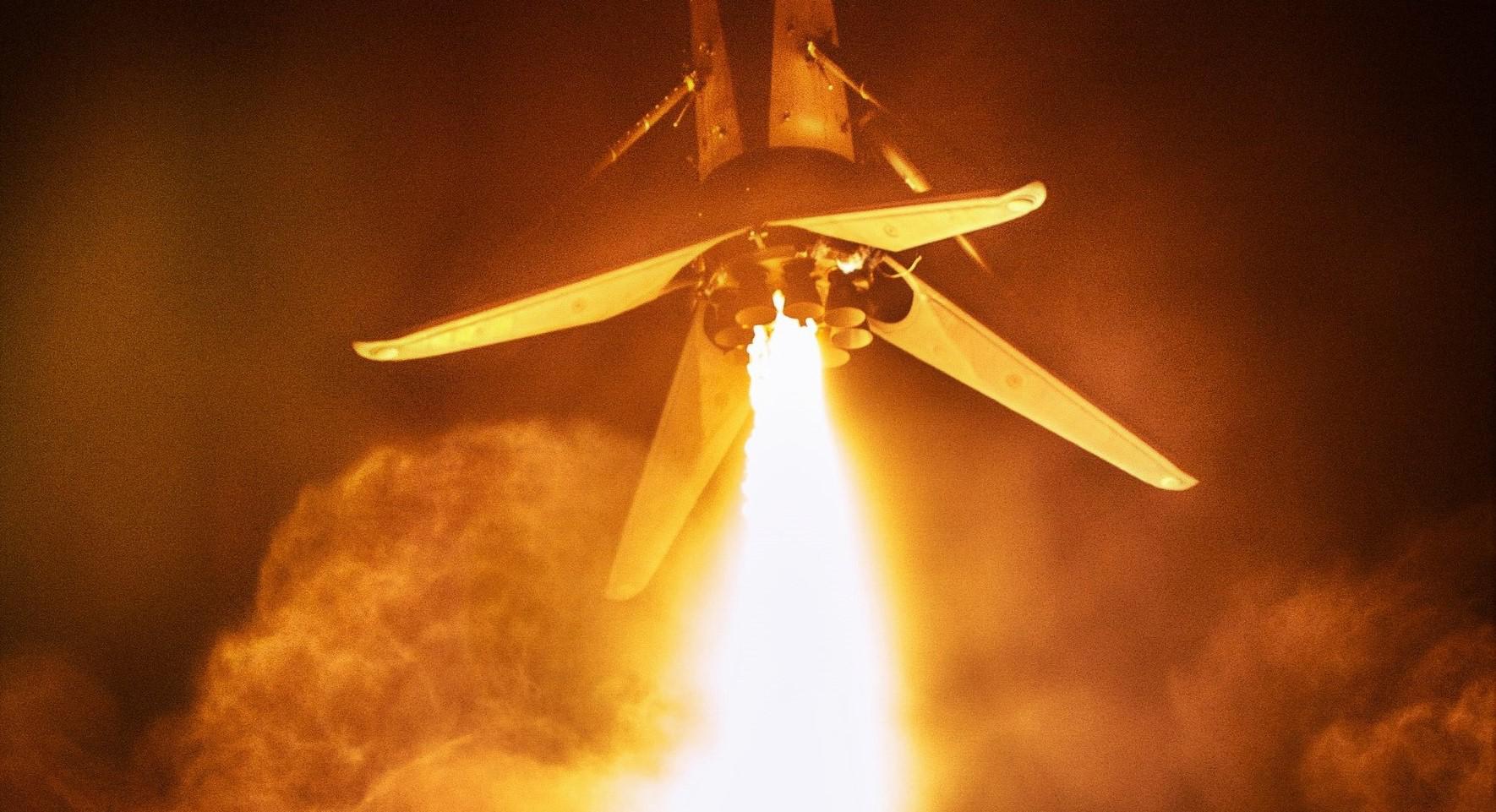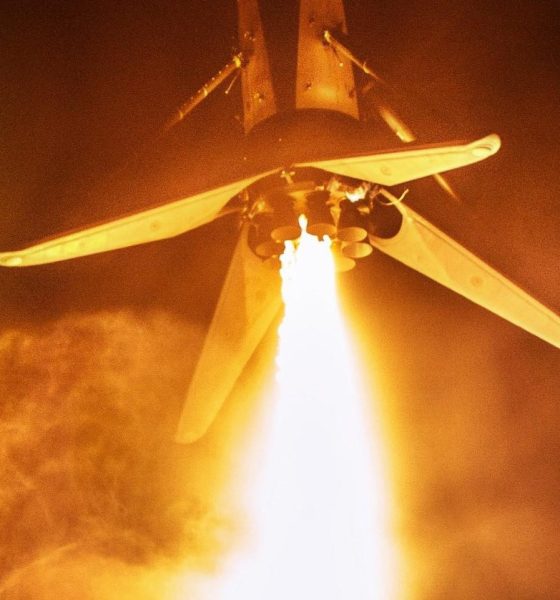

SpaceX
SpaceX static fires Falcon 9 for West Coast pad’s second booster landing ever
SpaceX has completed a static fire of Falcon 9 ahead of the company’s second California launch of 2019, also set to include the second ever use of SpaceX’s West Coast landing zone, known as LZ-4.
In a rare event, the Radarsat Constellation Mission’s (RCM) launch was expedited approximately five days to January 12th. Minor delays during prelaunch processing have pushed RCM back 24 hours and liftoff is now scheduled for 7:17 am PT (14:17 UTC, June 12th. Assigned to the mission is booster B1051.2, tasked with supporting Crew Dragon’s orbital launch debut on March 2nd, roughly 100 days prior.
As previously discussed on Teslarati, RCM’s journey to launch has been exceptionally arduous for a SpaceX mission, involving more than half a year of delays as a result of equally exceptional anomalies and requirements.
“Once the three RCM satellites were effectively complete, a series of unfortunate circumstances combined to delay the constellation’s launch almost indefinitely. The first domino fell in December 2018, when Falcon 9 Block 5 booster B1050 – having successfully supported Cargo Dragon’s CRS-16 launch – suffered a failure that prevented a successful landing. Incredibly, the booster did survive its accidental Atlantic Ocean landing and is now sitting in a SpaceX hangar, but B1050 is unlikely to ever fly again.
In short, had Maxar/CSA waited for a new booster, RCM’s launch would likely be delayed at least another 30-60 days beyond its current target of June 11th. Instead, they downselected to Falcon 9 B1051, then in the midst of several months of prelaunch preparations for Crew Dragon’s launch debut (DM-1). DM-1 went off without a hitch in early March, after which the gently-used B1051 underwent a brisk ~45 days of inspection and refurbishment before heading west to SpaceX’s VAFB launch pad.”
98 days after B1051’s launch and landing debut, the reintegrated rocket ignited all nine of its Merlin 1D engines for a handful of seconds, paving the way for the vehicle’s second launch – this time supporting three radar satellites instead of a Crew Dragon spacecraft. Due to the fact that the three RCM satellites – $400M over budget for a total cost of >$1B – represent no less than 3-5 years of Canadian Space Agency’s entire annual budget, mission assurance is exceptionally desirable for both the customer and launch provider.
A lot of that “mission assurance” can often take the shape of practices that could be accurately described as ritualistic, but many additional (and time-consuming) tweaks can be added to – at a minimum – raise the customer’s confidence in the likelihood of success. That can often be as simple as triple-checking instead of double-checking (just an analogy) but it can quickly gain complexity as statistical models of risk and more substantial changes are thrown into the mix
Complexities aside, things are looking good as SpaceX enters into the final stages of launch preparations. All three satellites – weighing ~4300 kg (9500 lb) total – have been encapsulated inside the payload fairing, B1051 has completed a routine wet dress rehearsal and static fire, and SpaceX technicians are likely attaching the fairing to the integrated Falcon 9 as we speak. Meanwhile, despite an apparent regulation preventing SpaceX from landing boosters at its Californian LZ-4 pad during harbor seal pupping season (“March to June”), B1051 is expected to land at LZ-4 and drone ship Just Read The Instructions remains in port.
As per usual, SpaceX will offer live coverage of the launch from roughly T-15 minutes to spacecraft separation. Tune in around 7am PT (14:00 UTC), June 12th.
Check out Teslarati’s Marketplace! We offer Tesla accessories, including for the Tesla Cybertruck and Tesla Model 3.

Elon Musk
Starlink passes 9 million active customers just weeks after hitting 8 million
The milestone highlights the accelerating growth of Starlink, which has now been adding over 20,000 new users per day.

SpaceX’s Starlink satellite internet service has continued its rapid global expansion, surpassing 9 million active customers just weeks after crossing the 8 million mark.
The milestone highlights the accelerating growth of Starlink, which has now been adding over 20,000 new users per day.
9 million customers
In a post on X, SpaceX stated that Starlink now serves over 9 million active users across 155 countries, territories, and markets. The company reached 8 million customers in early November, meaning it added roughly 1 million subscribers in under seven weeks, or about 21,275 new users on average per day.
“Starlink is connecting more than 9M active customers with high-speed internet across 155 countries, territories, and many other markets,” Starlink wrote in a post on its official X account. SpaceX President Gwynne Shotwell also celebrated the milestone on X. “A huge thank you to all of our customers and congrats to the Starlink team for such an incredible product,” she wrote.
That growth rate reflects both rising demand for broadband in underserved regions and Starlink’s expanding satellite constellation, which now includes more than 9,000 low-Earth-orbit satellites designed to deliver high-speed, low-latency internet worldwide.
Starlink’s momentum
Starlink’s momentum has been building up. SpaceX reported 4.6 million Starlink customers in December 2024, followed by 7 million by August 2025, and 8 million customers in November. Independent data also suggests Starlink usage is rising sharply, with Cloudflare reporting that global web traffic from Starlink users more than doubled in 2025, as noted in an Insider report.
Starlink’s momentum is increasingly tied to SpaceX’s broader financial outlook. Elon Musk has said the satellite network is “by far” the company’s largest revenue driver, and reports suggest SpaceX may be positioning itself for an initial public offering as soon as next year, with valuations estimated as high as $1.5 trillion. Musk has also suggested in the past that Starlink could have its own IPO in the future.
News
SpaceX shades airline for seeking contract with Amazon’s Starlink rival

SpaceX employees, including its CEO Elon Musk, shaded American Airlines on social media this past weekend due to the company’s reported talks with Amazon’s Starlink rival, Leo.
Starlink has been adopted by several airlines, including United Airlines, Qatar Airways, Hawaiian Airlines, WestJet, Air France, airBaltic, and others. It has gained notoriety as an extremely solid, dependable, and reliable option for airline travel, as traditional options frequently cause users to lose connection to the internet.
Many airlines have made the switch, while others continue to mull the options available to them. American Airlines is one of them.
A report from Bloomberg indicates the airline is thinking of going with a Starlink rival owned by Amazon, called Leo. It was previously referred to as Project Kuiper.
American CEO Robert Isom said (via Bloomberg):
“While there’s Starlink, there are other low-Earth-orbit satellite opportunities that we can look at. We’re making sure that American is going to have what our customers need.”
Isom also said American has been in touch with Amazon about installing Leo on its aircraft, but he would not reveal the status of any discussions with the company.
The report caught the attention of Michael Nicolls, the Vice President of Starlink Engineering at SpaceX, who said:
“Only fly on airlines with good connectivity… and only one source of good connectivity at the moment…”
CEO Elon Musk replied to Nicolls by stating that American Airlines risks losing “a lot of customers if their connectivity solution fails.”
American Airlines will lose a lot of customers if their connectivity solution fails
— Elon Musk (@elonmusk) December 14, 2025
There are over 8,000 Starlink satellites in orbit currently, offering internet coverage in over 150 countries and territories globally. SpaceX expands its array of satellites nearly every week with launches from California and Florida, aiming to offer internet access to everyone across the globe.
Currently, the company is focusing on expanding into new markets, such as Africa and Asia.
News
Tesla hints at Starlink integration with recent patent
“By employing polymer blends, some examples enable RF transmission from all the modules to satellites and other communication devices both inside and outside the vehicle.”

Tesla hinted at a potential Starlink internet terminal integration within its vehicles in a recent patent, which describes a vehicle roof assembly with integrated radio frequency (RF) transparency.
The patent, which is Pub. No U.S. 2025/0368267 describes a new vehicle roof that is made of RF-transparent polymer materials, allowing and “facilitating clear communication with external devices and satellites.”
Tesla believes that a new vehicle roof design, comprised of different materials than the standard metallic or glass elements used in cars today, would allow the company to integrate modern vehicular technologies, “particularly those requiring radio frequency transmission and reception.
Tesla has recently filed a US patent application on integrating RF transparent materials into the roof structure.
“facilitating clear communication with external devices and satellites”
Tesla fleet is getting @Starlink connectivity integration soon. LFG @Tesla @elonmusk… pic.twitter.com/bLa8YtPLd1
— Chansoo Byeon (@Chansoo) December 9, 2025
Instead of glass or metallic materials, Tesla says vehicles may benefit from high-strength polymer blends, such as Polycarbonate, Acrylonitrile Butadiene Styrene, or Acrylonitrile Styrene Acrylate.
These materials still provide ideal strength metrics for crashworthiness, stiffness for noise, vibration, and harshness control, and are compliant with head impact regulations.
They would also enable better performance with modern technologies, like internet terminals, which need an uninterrupted signal to satellites for maximum reception. Tesla writes in the patent:
“By employing polymer blends, some examples enable RF transmission from all the modules to satellites and other communication devices both inside and outside the vehicle.”

One of the challenges Tesla seems to be aware of with this type of roof design is the fact that it will still have to enable safety and keep that at the forefront of the design. As you can see in the illustration above, Tesla plans to use four layers to increase safety and rigidity, while also combating noise and vibration.
It notes in the patent that disclosed examples still meet the safety requirements outlined in the Federal Motor Vehicle Safety Standards (FMVSS).
Starlink integrated directly into Tesla vehicles would be a considerable advantage for owners. It would come with a handful of distinct advantages.
Initially, the inclusion of Starlink would completely eliminate cellular dead zones, something that is an issue, especially in rural areas. Starlink would provide connectivity in these remote regions and would ensure uninterrupted service during road trips and off-grid adventures.
It could also be a critical addition for Robotaxi, as it is crucial to have solid and reliable connectivity for remote monitoring and fleet management.
Starlink’s growing constellation, thanks to SpaceX’s routine and frequent launch schedule, will provide secure, stable, and reliable internet connectivity for Tesla vehicles.
Although many owners have already mounted Starlink Mini dishes under their glass roofs for a similar experience, it may be integrated directly into Teslas in the coming years, either as an upgrade or a standard feature.








